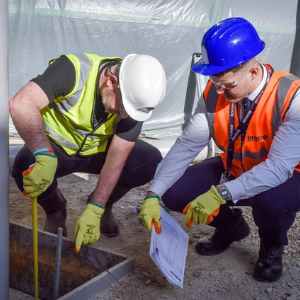In the hustle and bustle of cities, space is at a premium, and sustainability is paramount – some of the many reasons bicycles have emerged as a favourite mode of transport. Recent data from Transport for London shows that over 24% of Londoners reported cycling as a primary mode of transport last year.
However, with the rise in cycling comes the pressing challenge of bike storage, which is where two-tier bike racks come in, offering a convenient and efficient solution to this issue.
What are two-tier bike racks?
Two-tier bike racks are bicycle storage systems that allow you to park one bike on top of another on two separate rows, effectively doubling the capacity of the bike storage area. They are commonly used in areas with limited space, such as urban environments or parking garages.
Cyclists can access the upper level by lifting or carrying their bikes up a ramp. This type of bike rack is a space-efficient solution for accommodating many bicycles in a limited area.




What are the benefits of two-tier bike racks?
Two-tier bike racks offer several benefits, including maximising the space available by allowing bikes to be stored at two different levels on the same rack. This can be especially useful in areas with limited space, such as train stations, apartment blocks and universities.
Two-tier bike racks also provide secure storage and strong accessibility. Gas-assisted two-tier bike racks require minimal effort to slide the bike upwards to rest on the second level. For the other models that don't feature gas assist, you pull the upper track out, roll your bike on, and manually push it back up again. See our mechanisms of operation below for more detailed information.
Structural design and materials of two-tier bike racks
The two-tier bike rack is designed with functionality and durability in mind, utilising mild steel that has been finished galvanised to BS EN ISO 1461:2009 standards. This specific choice of material offers excellent strength and corrosion resistance, making it suitable for outdoor use and ensuring a long-life service.
The structural design incorporates two tiers to maximise bike storage within a limited space, allowing for efficient use of the available area. The use of mild steel provides the necessary rigidity to support the weight of multiple bikes, while the galvanisation process adds an extra layer of protection, safeguarding the rack against rust and other environmental damage. This results in a robust and reliable two-tier bike rack that can withstand the elements and securely accommodate bicycles.
Dimensions and spatial efficiency
Although there is flexibility in designing a bicycle parking area, there are guiding principles for cycle parking set out by the UK Cycle Parking Standard and Transport for London that must be met.
The dimensions of two-tier bike racks can vary, but a standard rack usually requires a 3744mm operating space and a 2455mm minimum height clearance to accommodate stacked bicycles. The minimum aisle width between two rows of two-tier racks facing each other should be 2000mm. The same distance should be maintained between the loading area and a wall or the perimeter of a shelter or fencing to ensure safe bike loading and unloading. Considering typical bike dimensions, no two-tier bike rack will safely operate under a ceiling height of 2600mm.
When setting up a bike parking area, it's important to consider the proper loading distances, aisle widths, and ceiling heights around the racks.
The minimum spacing between Sheffield stands (which can be found on the bottom tier of some of our Easi-Riser 2-Tier Cycle Racks) must be 750mm, always measured from the centre line of the stand. Aisles between rows of Sheffield stands are important for users to access the stands with their bikes. These aisles should be a minimum of 1200mm wide, as the footprint of a person wheeling a bicycle is approximately 1100mm wide.
The stacked design allows for clear delineation of parking spaces, minimising clutter and optimising the overall layout of the bike parking area. The vertical orientation of the racks provides an organised and visually appealing solution, contributing to an aesthetically pleasing environment.


Mechanisms of operation
Here's a step-by-step guide for safely loading a bicycle onto the upper tier of a two-tier cycle rack.
1. When releasing the cycle rack, you must take the handle and lift it slightly, then start to pull the cycle rack towards you carefully.
2. When the rack is fully extended, carefully lower it, placing it on the ground.
3. Lift the front wheel of the bicycle into the tray.
4. Take the bicycle firmly by the seat and the handlebar and lift the back wheel into the tray.
5. Use your preferred locking device to secure the bicycle to the tray.
6. Now the bicycle is securely attached to the tray. Take the rack handle and carefully lift the rack from the ground.
7. Once the rack is lifted from the ground, carefully slide it back to its fully stowed position.
When using the Sheffield Hoops, you may only access or lock up your bicycle if the above rack is fully stowed and there is sufficient space around you to manoeuvre. Please be aware of the restricted headroom with the Sheffield Racks.
Lift-assisted vs Manual lift
In terms of design, both our Eco-2-Tier Cycle Rack (Manual Lift) and Easi-Riser 2-Tier Cycle Rack (Lift Assisted) have the same size, specifications, material and options. However, the Easi-Riser offers more convenience as it has a gas strut mechanism to help load and unload bicycles, while the Eco-2-Tier is a manually operated lift.
Due to the weight of the motors/batteries, our Eco-2-Tier is suitable for push bikes only, not e-bikes. On the other hand, our Easi-Riser 2-Tier Cycle Rack can handle all push bikes, including e-bikes up to 30kg.


Safety features
Our 2-tier cycle racks are equipped with several safety features to ensure the security of the bicycles. They have been designed and manufactured with sturdy materials to support the weight of the bikes and prevent them from falling.
The spacing between the tiers is calculated to prevent handlebars and pedals from getting entangled. This reduces the risk of damage to the bicycles and makes it safer for users to manoeuvre their bikes in and out of the rack.
In terms of safety, a gas lift-assisted 2-tier cycle rack is considered much safer than its manual lift counterpart. Manual lift 2-tier cycle racks require a significant amount of strength to operate the upper tier and lift the tray back into position. The gas spring supports lifting the rack with the bicycle in place and prevents the upper tier from falling to ground level.
For added safety, you can choose to add reflective handles and rubber banding to the U-shape divot on your 2-tier bike rack. These additional options can give you extra peace of mind, knowing that all rack users will be protected and can easily identify and grip the handles to pull the trays down.
Choosing Broxap for efficient cycle parking
Two-tier bike racks combine robust materials, smart design, and user-friendly features to address the growing need for efficient bike storage in urban UK areas. By leveraging vertical space, enhancing security, and ensuring ease of use, these racks meet modern city demands and promote sustainable transportation practices.
Our experienced team of advisers is available to discuss your current and future cycle parking requirements and the best products and systems to meet users' needs.
Get in touch today and advance your cycle parking infrastructure.


















